Denim is denim, right? Not exactly. From weave to finish, denim materials have a number of characteristics...Read more ▸

Sourcing cotton from Egypt
- By Katie Syk
When was the last time you put on a pair of jeans and really felt good in them? Perhaps your go-to pair is just that. Or maybe you can’t remember feeling the difference. We’re talking about the pair that fits you just right. The pair that hugs your curves in all the right places. The pair that makes you feel amazing the moment you pull them on. It’s about the model and size of the jean, of course. But it’s more than that. It’s about the actual make-up of the fabric fibers themselves. The yarn that’s been spun and woven into this fabric. And there’s a pretty good chance that pair of jeans you can’t stop thinking about got started on a farm in Egypt’s fertile Nile River Valley.

Cotton is to Egypt what pasta is to Italy – it’s ingrained in the country itself, in its people, its culture, even in its history. Given this, it’s no wonder Egyptian cotton is in such high demand. The Egyptian trademark translates to quality, durability, a softness like no other. But how is it that Egypt produces such high-quality cotton? And what makes cotton good anyway? We took a deep dive into the world of cotton in Egypt and made some pretty interesting discoveries along the way.
On record, the growth of cotton in Egypt started as far back as 2500 BC. Cotton seeds have been found in this area from the Nubian period, one of the earliest centers of civilization on the planet. Sculptures and hieroglyphic symbols show the importance of cotton and, a bit later, the growth of this crop was central throughout the Roman period.
In more recent history, the United States became a major cotton producer – but during the Civil War in the mid-19th century, this source was cut off. Egypt stepped up to the plate and focused its entire agricultural market on growing cotton for a period of time. While the country’s output has experienced ups and downs since then, in just the last few years, Egyptian cotton has seen an uptick.

Just what is it about Egyptian cotton?
Historically, the Nile River’s yearly floods meant that the soil surrounding it was regularly enriched with volcanic silt. For thousands of years, crops grew heartily in this region – and cotton was no exception. However, these floods were unpredictable and often came at the cost of destruction and poverty. For this reason, the Nile River’s Aswan Dam was constructed in the 1960s, allowing the annual floods to be controlled and providing a source of water for irrigation all year long.
Now, when it comes to the cotton itself, this rich soil is conducive to growing sturdy, long cotton staples, which are the white fluffy cotton balls that grow as the flowers of the cotton plant. One cotton staple contains around 250,000 cotton fibers. It’s not about the number, though, but the length of those fibers that determines the quality of the cotton. The longer the fibers, the better quality. And the Nile River Valley grows some impressively long fibers.
Cotton is to Egypt what pasta is to Italy – it’s ingrained in the country itself, in its people, its culture, even in its history.
Long cotton fibers – like the ones grown in Dream of Nile’s Giza 94 variety – are what create soft, smooth, sturdy denim. They also hold dye better than other fibers so that they appear brighter in color and hold their color for longer. What’s more, these long, thin fibers can be woven more tightly for that coveted high thread count. The result? A smooth, soft, sturdy denim that’s both luxurious and durable for quality that lasts.
Incorporating Egyptian cotton – specifically the luxurious Giza cotton variant – into your upcoming denim line is possible through our Egyptian cotton collection here:
Take a look at the fabric options available here, and feel free to order a free sample of any that catch your eye.
Related content
Differentiation is key when it comes to the success of fashion brands within a competitive market. And...Read more ▸
The recycling of fabrics is well-covered in the press, and donation sites are aplenty for end-of-life garments...Read more ▸
Material Exchange and Texworld have partnered up to create a completely unique tradeshow experience for brands seeking...Read more ▸



